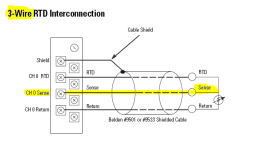ceilingwalker
Lifetime Supporting Member
Good day all. I have a SLC-5/03 that has in its chassis an RTD Module (1746-NR4). The system was running fine but we had to move the cabinet from its original position (about 15 feet from the tanks)to a more distant location (about 60 feet from tanks). All new wire was pulled. When I attach my RTD directly to the module it works just fine, reads 75 degrees. When I connect the RTD to the field wiring I now get a temp reading of 32 degrees. Would anyone here happen to know what might be causing this? Thank you.



